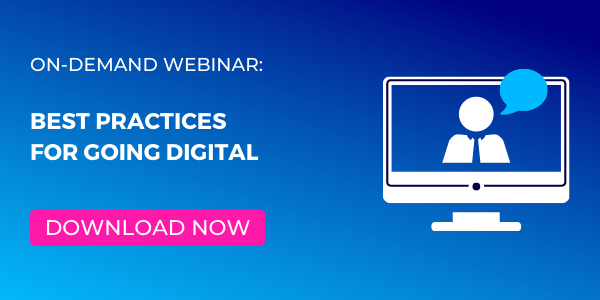With the shift to fully remote work, employers across the world were forced to adapt their processes, products and business models. Even so, companies were headed for digital transformations prior to 2020 — invigorating their business with the transformative power of tech.
Today, companies of all sizes and industries are undergoing digital transformations, which begs the question: what are the best practices for going digital? We spoke with two leading talent acquisition experts for their thoughts and tips. Below are five key takeaways from the conversation, but be sure to download the recording of the webinar to hear the full discussion.
ON-DEMAND WEBINAR: BEST PRACTICES FOR GOING DIGITAL. DOWNLOAD NOW.
1. Talent acquisition is the backbone of digital transformations.
In order to keep up with the pace of innovation, it’s imperative that you continuously add to your team. As always, your headcount goals should closely align with your business goals. Why? “We have to have the right people in the right places to support our needs,” said Mira Hermanson, Global Director of Talent Acquisition for Technology, Data Science & Product Leadership at NielsenIQ. “Without the people, you can do nothing.”
2. Your recruitment process must evolve, too.
Especially after a year like 2020 in which the personal touches of an in-person interview — a one-on-one with a prospective manager; a tour of the office — were removed entirely. You must find ways to infuse your culture and employee value proposition (EVP) into your recruitment process.
Travis Kessel, VP of DMED & Technology Talent Acquisition at The Walt Disney Company, explained that the team has benefited from the switch to remote: “It not only created a lot more ease for coordinators to move interviews much more quickly, but we also found that candidates actually appreciated not having to take an entire day off of work to come in and meet with us.”
3. Adopt a competency-based hiring model.
Regardless of the volume of hiring, your recruitment process should focus on competency-based assessments. This not only enables recruiters to better assess tech qualifications and skills, but naturally removes biases and personal preferences from the process.
“Where I'm pushing us to go is to apply a competency-based model and tie everything back to the role,” said Hermanson. “Defining the key criteria that a person will have to accomplish in the position to be successful, and then backing into how we properly assess for that in a very role-based, realistic way, and using tools that mimic the actual environment.”

4. Establish a strong partnership with HR.
Talent acquisition professionals and recruiters are charged with the task of selling prospective employees on the company and its open roles. However, you must be conscious of what happens when they get here.
Again, you can’t transform your business and digitize processes without a team of talented people on your side. That means that as hard as you work to recruit new tech professionals, you need to work just as hard to retain them. “At the end of the day, we can bring the people in, but the organization that they're coming into, has to be a reflection of that,” said Hermanson.
5. Before you take a step forward, get back to basics.
We were all innovating, changing and adapting so rapidly in 2020 that it’s important you take the time to ensure your team is fully aligned before moving forward and checking off this year’s to-dos.
“I met with everyone individually in my first two months on the job,” said Kessel. “They told me what they needed and the feedback was very clear: it was difficult to do their job because they were trying to support all these different businesses.” By first talking to team members, Kessel was able to understand their needs, identify problems and ultimately reorganize the team to clear roadblocks.
Use these guidelines to align your team’s digital transformation with your TA goals. But remember, digitizing your business is a big to-do, and these takeaways only scratch the surface: download the full on-demand webinar to learn more from industry experts.
ON-DEMAND WEBINAR: BEST PRACTICES FOR GOING DIGITAL. DOWNLOAD NOW.




